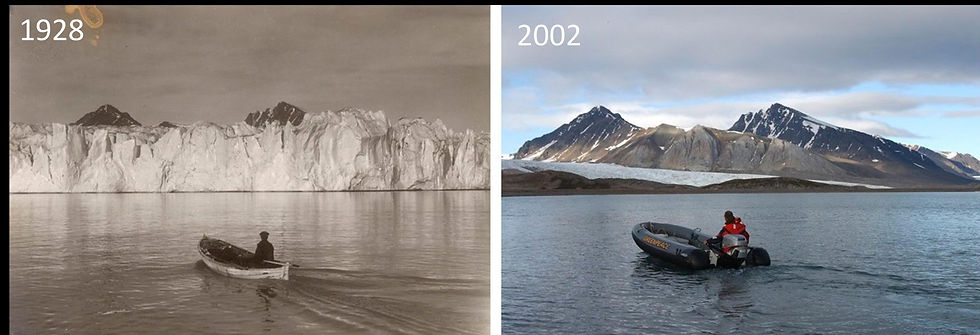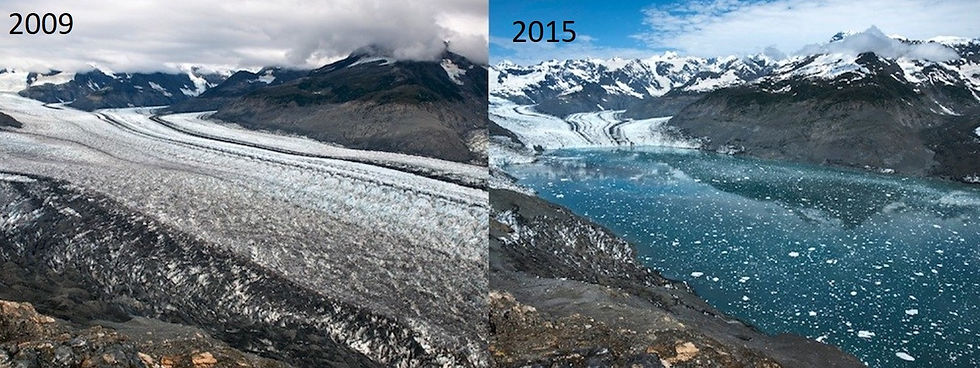Socio-economics & Climate Change
- vicluca
- Jun 27, 2022
- 7 min read
Updated: Aug 26, 2022
Victor Luca
27-Jun-22, Unpublished
The tremendous capacity that gases such as carbon dioxide have to absorb heat and alter climate was first demonstrated more than 150 years ago by Joiin Tyndall and then Svante Arrhenius. Since that time irrefutable scientific evidence has accumulated that the burning of fossil fuels generates carbon dioxide and other gases that endanger our planet’s ability to maintain temperatures that are suitable to organized human life.

Figure 1. (a) Thwaites (doomsday) glacier, Antarctica, (b) Larsen C ice shelf, Antarctica, showing a new crack that developed in 2017, (c) example of permafrost thaw and (d) destruction of infrastructure due to permafrost thaw.
The first general warning to humanity regarding global warming was published in 1992 by the Union of Concerned Scientists. This warning was co-signed by 1,700 eminent scientists, including all Nobel laureates of the day. This first warning was followed up in 2017 by a second warning that was co-signed by 15,364 eminent scientists. A third warning was issued in 2019 related to ecosystem destruction.
Recent studies have established that the scientific consensus on human-caused climate change now exceeds 99.0%. Despite these and other warnings over the past decades, and recent shrill warnings by the IPCC and other professional bodies, little or nothing seems to deter our relentless march to self-destruction. More recently the question seems to be shifting from, not if human-caused climate change is occurring, to whether it is too late to do anything about it.
Although the degradation of Earth systems by humans is concerning and terrifying, these are symptoms of a more deep-rooted disease. The cause is the extraordinary ‘success’ of the human species and our inability to comprehend exponential growth and planetary limits coupled with a flagrant disregard for the impact we have on the systems that support us.
Scientific and technological advance has allowed us to live longer and dedicate more time to other productive and leisure activities. Two hundred years ago we lived much shorter lives and 99% of us would have spent most of our short lives doing hard labor associated with food production. Today, in developed countries, science and technology allows us to satisfy nutritional requirements of large numbers of people with a tiny fraction of the workforce thus freeing up the majority of us to do other things. In the future it is envisaged that automation will likely make many of us surplus to requirements. There may even be no need for the majority of humanity to work at all as the robots will do the hard yakka.
A system of quantitative computation facilitated by the advent of modern computers allowed MIT scientists in the early seventies to estimate when we would be in what was referred to as ‘overshoot’. Overshoot is when consumption would exceed Earth’s resource base. This system of computation was described in the famous book Limits to Growth that was published in 1972. The date at which overshoot was expected to occur was around the year 2000 give or take a decade or two.
So convinced was I more than three decades ago of the reality of human-induced climate change that I directed my own research toward climate change mitigation technologies including in lithium ion batteries and the photoelectrochemical generation of hydrogen.
In the 30 years since I started that work all I have witnessed is prevarication, vacillation and ignorance. Only now are we starting to see the very early stages of a desperately needed clean energy transition, although how clean it ultimately turns out to be remains to be seen. Whilst I am glad that that an incipient transition is finally underway, it has been very slow to get going and much precious time has been squandered. Weaning ourselves off our century-long fossil fuel addiction is not proving easy.
After half a century of denial and white-washing, the fossil fuel industry has now turned itself to green-washing. Even the much publicized COP 26 climate change conference held in Glasgow recently (31-Oct-13-Nov-21) turned out to be a relatively lame affair with too many concessions made to fossil fuels.
Although some progress was made, there is still much ignorance of the fact that climate change and environmental degradation are the result of the immense success of our species and acknowledgement that the coupling of scientific and technological advancement with a rapacious form of capitalism have combined to produce a toxic brew.
We desperately need a clean energy transition but we seem to be unaware of the fact that this transition requires the consumption of resources. For instance, for their manufacture, solar panels require a pure silica (SiO2) feed, lithium-ion batteries require lithium, nickel, cobalt, manganese and wind turbines require rare earth elements. Cars are complex objects requiring a wide assortment of elements including all the aforementioned elements plus aluminium, iron, polymers and so forth. The extraction of these elements is energy intensive. The complexity of modern automobiles makes them very difficult to deconstruct and recycle economically and the process is also energy intensive. That energy has traditionally been provided by cheap and abundant fossil fuels. It is what kicked off the industrial revolution in the first place.
As you read this article and look at your surroundings it should not be hard to figure out that everything you see was extracted through the exploitation of Earth’s limited resources. From the bricks and mortar, steel and wood from which your home is built, the car you drive, the roads you drive on, the device you are using to read this column, the food you eat, air you breathe and water you drink. All of it!
Some have become intoxicated by the fantasy of green growth. That is, the belief that we can continue to grow in a manner that is benign to the environment.
Meanwhile, extreme weather events are increasing in frequency and intensity and we are approaching tipping points in the climate system. These tipping points occur when we hit a negative feedback loop in the climate system that cannot be halted. For instance, the melting of ice reduces the back reflection of heat into the atmosphere which causes more warming which causes more ice to melt.
Currently, it is known that heating of the Polar Regions is occurring at 2-4 times the rate of the global average and this can hasten the melting of land and sea ice and the thawing of permafrost (Figure 1c).
Permafrost is frozen soil primarily found in the arctic regions. Not only does the melting of permafrost release carbon dioxide and methane, it also directly threatens billions of dollars of infrastructure (Figure 1d). Permafrost thaw also poses serious health risks since it is being increasingly recognized that bacteria and viruses locked in the permafrost for thousands of years could be released.

Melting of Polar ice also has the potential to raise sea level significantly and glaciers the world over are in retreat (Figure 2). The Thwaites glacier (Figure 1a), often referred to as ‘the doomsday glacier’, is one of the largest and evidence shows that it is at risk of parting company with the West Antarctic ice shelf. If this occurs, and the ice shelf melts, we are in for six meters of sea level rise. Melting of Greenland would contribute seven meters of sea level rise and Antarctica 57 meters. I have only addressed parts of the cryosphere which is only one of Earth’s systems that are threatened with collapse. I will not mention the other problems that the increasing frequency of extreme weather events will pose and the number of climate refugees that will be generated looking for a new place to live.
It is also pretty clear that folk in our country living in coastal zones will not be spared either.
So how do we reconcile our relentless and obsessive pursuit of growth with the fact that we live on a finite planet? What must we do about all this?
I would like to believe that science can provide the tools to give us a fair chance of saving ourselves. However, societal and political will would still need to be mustered to act with urgency.
In 2006, the UK economist, banker and academic, Nicholas Stern, and his team, released a comprehensive review in which it was concluded that it was cheaper in economic terms to address climate change than to try to fix the mess once it happens, if it can be fixed at all. Sixteen years on and the Stern review is seldom mentioned and scant progress has been made.
Among the many inventions of modern man is an economic system in which money having no intrinsic value is created from thin air by governments. But money and value are not the same thing. Although it might be said that money makes the world go round, it is idiotic to think you can count the value of the life-support systems that sustain human life in dollar terms.
Where the money that governments create from thin air is spent is largely a political decision. Much of the money that we create goes toward speculation and is not directed toward productive activities that guarantee that our offspring, and theirs, will continue to prosper on this planet. What will we do with this money when we don’t have a viable planet on which to live?
In April last year I gave a two and a half hour introductory lecture on the Science of Climate Change. That few people attended leads me to the conclusion that most people don’t give a stuff. If I am flooded with requests to repeat the performance, it may give me hope that some in our community do care. I wont hold my breath.
References
[1] Elhacham et al., Global human-made mass exceeds all living biomass. Nature 2020, 1476
[2] Goymann, W., Küblbeck, M. The second warning to humanity - Why ethology matters? Ethology. 2019, 00, 1-9. https://doi.org/10.1111/eth.12965
[3] Hauer et al., Sea-level rise and human migration. Nature Rev. Earth Environ. 2020,1, 28.
Kehoe, L. The Great Extinction Crisis. Irish Marxist Rev. 2018, 7, 60.
[4] Kendall, Henry W., World Scientists Warning To Humanity, (18 November 1992) ucsusa.org.
[5] Lynas et al., Greater than 99% consensus on human caused climate change in the peer-reviewed scientific literature. Environ. Res. Lett. 2021, 16, 114005.
[6] Ripple, William J. et al., "World Scientists' Warning to Humanity: A Second Notice". BioScience, 2017,67 (12), 1026–1028. doi:10.1093/biosci/bix125 (13 November 2017).

Columbia glacier

Boulder glacier

Carroll Glacier, Glacier Bay National Park and Preserve, Alaska, U.S.

Uppsala glacier, Patagonia, Argentina.



Comments